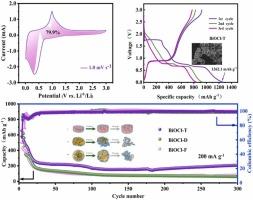室温液相共沉积法制备片剂状BiOCl锂离子电池负极材料
IF 6.3
2区 材料科学
Q2 CHEMISTRY, PHYSICAL
引用次数: 0
摘要
二维层状结构使BiOCl具有巨大的储能应用潜力。然而,其广泛应用受到循环过程中体积波动的限制。本文引入了一种新的形态策略,通过简单的室温液相共沉积制备了类片剂BiOCl-T,以减轻体积变化并加速稳定的电荷传输,从而提高Li⁺的存储性能。BiOCl-T的致密层状结构是通过选择性吸附十二烷基硫酸钠分子中的亲水磺酸基团形成的。这种结构促进了离子的快速扩散,提高了电解质的渗透。此外,紧凑的片剂状结构有效地适应了铋纳米颗粒在循环过程中的体积膨胀,消除了额外的应力缓解策略的必要性。作为锂离子电池的负极材料,BiOCl-T的初始库仑效率(73.6%)明显高于传统的花状和碎片状形态。它还表现出了显著的长期循环稳定性,在0.2 A g⁻¹下循环300次后,平均容量保持在95%。同时,BiOCl-T在大电流条件下表现出卓越的适应性,在0.5 g⁻¹下循环1000次后,其可逆容量是花朵状BiOCl-F和碎片状BiOCl-D电极的6.1倍和4.7倍。这项研究为高性能、耐用的铋基锂离子电池负极材料的设计提供了新的见解。本文章由计算机程序翻译,如有差异,请以英文原文为准。

Synthesis of tablet-like BiOCl as an anode material for lithium-ion batteries by room-temperature liquid-phase co-deposition
The two-dimensional layered structure endows BiOCl with significant potential for energy storage applications. However, its widespread application is limited by volume fluctuations during cycling. Herein, a new morphological strategy for tablet-like BiOCl-T, prepared via a simple room-temperature liquid-phase co-deposition, is introduced to alleviate volume variations and accelerate stable charge transport to boost Li⁺ storage performance. The compact laminated structure of BiOCl-T forms through the selective adsorption of hydrophilic sulfonic acid groups in sodium dodecyl sulfate molecules. This structure facilitates rapid ion diffusion and improves electrolyte infiltration. Furthermore, the compact tablet-like architecture efficiently accommodates the volume expansion of Bi nanoparticles during cycling, removing the necessity for additional stress-relief strategies. BiOCl-T, as an anode material for lithium-ion batteries, achieves a significantly higher Initial Coulombic Efficiency (73.6%) than conventional flower-like and debris-like morphologies. It also demonstrates remarkable long-term cycling stability, maintaining an average capacity retention of 95% after 300 cycles at 0.2 A g⁻¹. Synchronously, BiOCl-T shows exceptional adaptability under high-current conditions, delivering reversible capacities 6.1 and 4.7 times greater than those of flower-like BiOCl-F and debris-like BiOCl-D electrodes, after 1,000 cycles at 0.5 A g⁻¹. This study provides new insights into the design of high-performance, durable bismuth-based anode materials for lithium-ion batteries.
求助全文
通过发布文献求助,成功后即可免费获取论文全文。
去求助
来源期刊

Journal of Alloys and Compounds
工程技术-材料科学:综合
CiteScore
11.10
自引率
14.50%
发文量
5146
审稿时长
67 days
期刊介绍:
The Journal of Alloys and Compounds is intended to serve as an international medium for the publication of work on solid materials comprising compounds as well as alloys. Its great strength lies in the diversity of discipline which it encompasses, drawing together results from materials science, solid-state chemistry and physics.
 求助内容:
求助内容: 应助结果提醒方式:
应助结果提醒方式:


